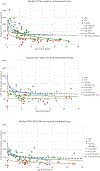Distinct immune trajectories in patients with chromosome 22q11.2 deletion syndrome and immune-mediated diseases
- PMID: 34144109
- PMCID: PMC11853714
- DOI: 10.1016/j.jaci.2021.06.007
Distinct immune trajectories in patients with chromosome 22q11.2 deletion syndrome and immune-mediated diseases
Abstract
Background: Identification of biomarkers associated with immune-mediated diseases in 22q11.2 deletion syndrome is an evolving field.
Objectives: We sought to use a carefully phenotyped cohort to study immune parameters associated with autoimmunity and atopy in 22q11.2 deletion syndrome to define biomarkers associated with immune-mediated disease in this syndrome.
Methods: Chart review validated autoimmune disease and atopic condition diagnoses. Laboratory data were extracted for each subcohort and plotted according to age. A random-effects model was used to define statistical significance.
Results: CD19, CD4, and CD4/45RA lymphocyte populations were not different from the general cohort for patients with atopic conditions. CD4/45RA T cells were significantly lower in the subjects with immune thrombocytopenia compared with the general cohort, and CD4 T-cell counts were lower in patients with autoimmune thyroid disease.
Conclusions: The mechanisms of autoimmunity in cytopenias may be distinct from those of solid-organ autoimmunity in 22q11.2 deletion syndrome. This study identifies potential biomarkers for risk stratification among commonly obtained laboratory studies.
Keywords: DiGeorge; atopy; autoimmunity; dysregulation; homeostatic proliferation.
Copyright © 2021 American Academy of Allergy, Asthma & Immunology. Published by Elsevier Inc. All rights reserved.
Conflict of interest statement
Disclosure of potential conflict of interest: The authors declare that they have no relevant conflicts of interest.
Figures


References
-
- Lingman Framme J, Borte S, von Dobeln U, Hammarstrom L, Oskarsdottir S. Retrospective analysis of TREC based newborn screening results and clinical phenotypes in infants with the 22q11 deletion syndrome. J Clin Immunol 2014;34:514–9. - PubMed
-
- Jawad AF, McDonald-Mcginn DM, Zackai E, Sullivan KE. Immunologic features of chromosome 22q11.2 deletion syndrome (DiGeorge syndrome/velocardiofacial syndrome). J Pediatr 2001;139:715–23. - PubMed
Publication types
MeSH terms
Grants and funding
LinkOut - more resources
Full Text Sources
Medical
Research Materials

